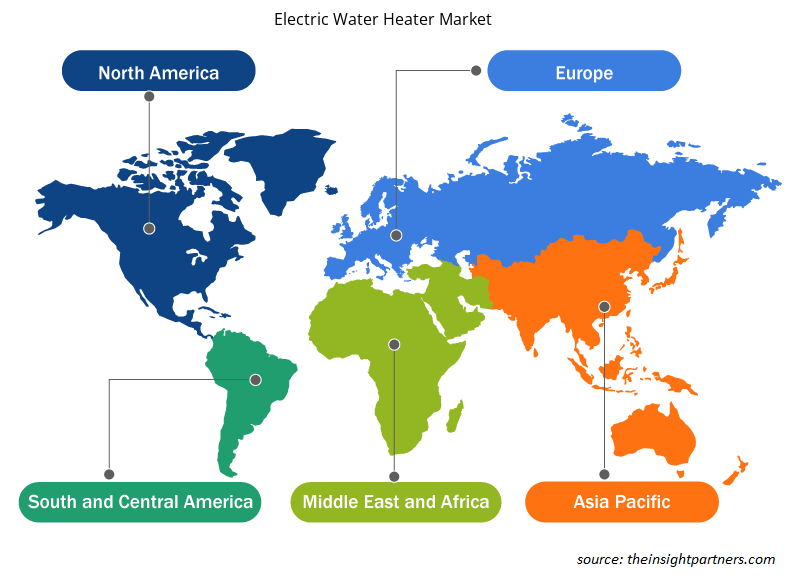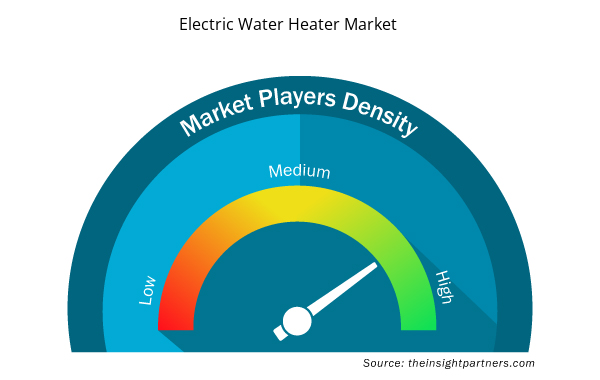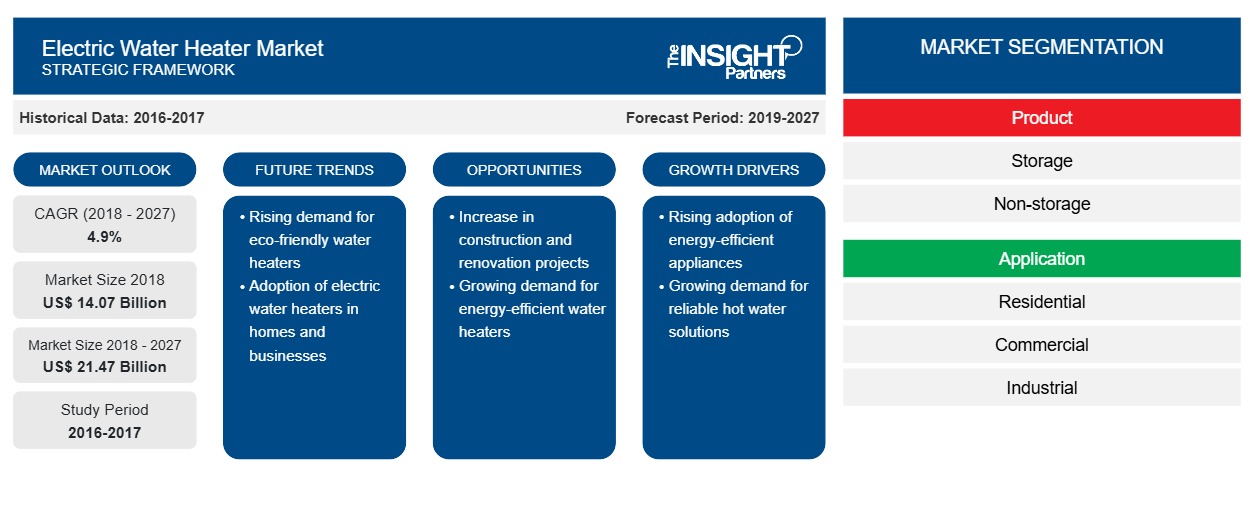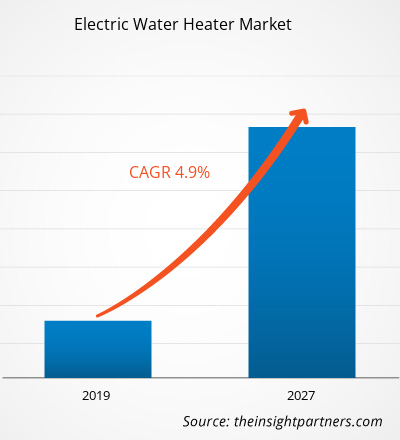Se espera que el mercado mundial de calentadores de agua eléctricos crezca de US$ 14.07 mil millones en 2018 a US$ 21.47 mil millones para el año 2027. Esto representa una CAGR del 4,9% desde el año 2019 hasta el 2027.
Asia Pacífico fue el principal mercado geográfico y se prevé que sea el que más ingresos aporte durante el período de pronóstico. En la región APAC, el rápido desarrollo de la infraestructura de varias unidades residenciales, comerciales e industriales está impulsando el mercado de calentadores de agua eléctricos de la región , y esto seguirá impulsando en los próximos diez años.
Perspectivas del mercado
El factor de inmigración urbana es un factor influyente clave para el mercado de calentadores de agua eléctricos
Diferentes países del mundo están experimentando una enorme tendencia a la migración urbana. La migración urbana es una tendencia creciente en el siglo XXI. Los parámetros clave que impulsan la tendencia de la migración urbana incluyen oportunidades laborales, oportunidades educativas y oportunidades médicas. Además, el aumento de los niveles de ingresos entre la sociedad de clase media y la mejora de los estándares de vida son factores clave que contribuyen a la reubicación urbana. La creciente tendencia de la migración urbana ha llevado al desarrollo de infraestructuras residenciales, que es un factor clave que cataliza el crecimiento del mercado de calentadores de agua eléctricos en el escenario actual.
La población urbana experimenta más beneficios que las áreas rurales y busca un mejor nivel de vida. En relación con el factor mencionado anteriormente, los diversos desarrolladores de tecnología, fabricantes de materias primas, organizaciones generadoras de energía y electricidad, desarrolladores de infraestructura y gobiernos se esfuerzan constantemente por satisfacer las demandas de la población urbana. La migración urbana y los niveles de vida más altos, junto con las crecientes tecnologías y políticas gubernamentales, impulsan el crecimiento de la infraestructura residencial en varios países en desarrollo, así como en las naciones desarrolladas. El creciente número de infraestructura residencial está facilitando que los actores del mercado de calentadores de agua eléctricos sean testigos del crecimiento de la demanda de sus respectivos productos.
Personalice este informe según sus necesidades
Obtendrá personalización en cualquier informe, sin cargo, incluidas partes de este informe o análisis a nivel de país, paquete de datos de Excel, así como también grandes ofertas y descuentos para empresas emergentes y universidades.
- Obtenga las principales tendencias clave del mercado de este informe.Esta muestra GRATUITA incluirá análisis de datos, desde tendencias del mercado hasta estimaciones y pronósticos.
La creciente infraestructura residencial en todo el mundo está permitiendo a los actores del mercado que operan en el mercado de calentadores de agua eléctricos mejorar su respectiva gama de productos para atraer a una amplia variedad de clientes. La conciencia de los beneficios y las áreas de aplicación de los calentadores de agua eléctricos está alcanzando su punto máximo entre la población urbana y, en relación con esto, la adopción de los mismos está creciendo continuamente, lo que luego proporciona el tamaño de los ingresos del mercado de calentadores de agua eléctricos. Por lo tanto, con la creciente migración de las áreas rurales a las áreas urbanas en diferentes países, la demanda de calentadores de agua eléctricos en el sector residencial se disparará en los próximos años. Por lo tanto, el factor de inmigración urbana es un factor influyente clave para el mercado de calentadores de agua eléctricos durante el período de pronóstico.
Información sobre el producto
El segmento de almacenamiento encabezó el mercado global de calentadores de agua eléctricos. El segmento sin almacenamiento ocupó el segundo lugar en el mercado en 2018 y se prevé que aumente su participación durante el período de pronóstico de 2019 a 2027.
Información sobre aplicaciones
El mercado mundial de calentadores de agua eléctricos por aplicación estuvo liderado por el segmento residencial. El segmento comercial ocupó el segundo lugar en el mercado en 2018 y se prevé que aumente su participación durante el período de pronóstico de 2019 a 2027.
Los actores del mercado de calentadores de agua eléctricos se centran principalmente en mejorar los productos mediante la implementación de tecnologías avanzadas. A continuación, se enumeran algunos de los desarrollos recientes:
2019: PHCC amplió el estatus de socio de Bradford White Corp. a la categoría de socio estratégico. El reconocimiento amplía la asociación de solo Bradford White Water Heaters a toda Bradford White Corp.
2019: Bradford White anunció el lanzamiento de su nuevo recurso para contratistas basado en la web, For The Pro, diseñado para instaladores profesionales de soluciones de calefacción de agua, calefacción de espacios, calefacción combinada y almacenamiento de Bradford White para aplicaciones residenciales, comerciales e industriales.
2018: AO Smith abrió el nuevo Centro de tecnología corporativa Lloyd R. Smith que serviría como su centro de innovación global para los productos de AO Smith en todo el mundo.
Perspectivas regionales del mercado de calentadores de agua eléctricos
Los analistas de Insight Partners explicaron en detalle las tendencias y los factores regionales que influyen en el mercado de calentadores de agua eléctricos durante el período de pronóstico. Esta sección también analiza los segmentos y la geografía del mercado de calentadores de agua eléctricos en América del Norte, Europa, Asia Pacífico, Medio Oriente y África, y América del Sur y Central.

- Obtenga datos regionales específicos para el mercado de calentadores de agua eléctricos
Alcance del informe de mercado de calentadores de agua eléctricos
| Atributo del informe | Detalles |
|---|---|
| Tamaño del mercado en 2018 | US$ 14.07 mil millones |
| Tamaño del mercado en 2027 | US$ 21,47 mil millones |
| Tasa de crecimiento anual compuesta (CAGR) global (2018-2027) | 4,9% |
| Datos históricos | 2016-2017 |
| Período de pronóstico | 2019-2027 |
| Segmentos cubiertos | Por producto
|
| Regiones y países cubiertos | América del norte
|
| Líderes del mercado y perfiles de empresas clave |
|
Densidad de actores del mercado de calentadores de agua eléctricos: comprensión de su impacto en la dinámica empresarial
El mercado de calentadores de agua eléctricos está creciendo rápidamente, impulsado por la creciente demanda de los usuarios finales debido a factores como la evolución de las preferencias de los consumidores, los avances tecnológicos y una mayor conciencia de los beneficios del producto. A medida que aumenta la demanda, las empresas amplían sus ofertas, innovan para satisfacer las necesidades de los consumidores y aprovechan las tendencias emergentes, lo que impulsa aún más el crecimiento del mercado.
La densidad de actores del mercado se refiere a la distribución de las empresas o firmas que operan dentro de un mercado o industria en particular. Indica cuántos competidores (actores del mercado) están presentes en un espacio de mercado determinado en relación con su tamaño o valor total de mercado.
Las principales empresas que operan en el mercado de calentadores de agua eléctricos son:
- Corporación AO Smith
- Ariston Thermo SpA
- Bajaj Electrics Ltd. es una empresa de fabricación de componentes eléctricos.
- Corporación Bradford White.
- Corporación Whirlpool
Descargo de responsabilidad : Las empresas enumeradas anteriormente no están clasificadas en ningún orden particular.

- Obtenga una descripción general de los principales actores clave del mercado de calentadores de agua eléctricos
MERCADO MUNDIAL DE CALENTADORES DE AGUA ELÉCTRICOS – SEGMENTACIÓN DEL MERCADO
Mercado mundial de calentadores de agua eléctricos por producto
- Almacenamiento
- < 30 litros
- 30 - 100 litros
- 100 - 250 litros
- 250 - 400 litros
- > 400 Litros
- Sin almacenamiento
Mercado mundial de calentadores de agua eléctricos por aplicación
- Residencial
- Comercial
- Industrial
Mercado mundial de calentadores de agua eléctricos por región
- América del norte
- Europa
- Asia Pacífico
- Oriente Medio y África
- Sudamerica
Empresas mencionadas
- Corporación AO Smith
- Grupo Ariston Thermo SpA
- Bajaj Electrics Ltd. es una empresa de fabricación de componentes eléctricos.
- Grupo Bosch
- Corporación Bradford White (BWC)
- Compañía de hogares inteligentes Haier, Ltd.
- Grupo Midea Co., Ltd.
- Siemens AG
- Viessmann Werke GmbH & Co. KG
- Corporación Whirlpool
- Análisis histórico (2 años), año base, pronóstico (7 años) con CAGR
- Análisis PEST y FODA
- Tamaño del mercado Valor/volumen: global, regional, nacional
- Industria y panorama competitivo
- Conjunto de datos de Excel



Report Coverage
Revenue forecast, Company Analysis, Industry landscape, Growth factors, and Trends

Segment Covered
This text is related
to segments covered.

Regional Scope
North America, Europe, Asia Pacific, Middle East & Africa, South & Central America

Country Scope
This text is related
to country scope.
Preguntas frecuentes
The demand for electric water heaters is expected to increase in the developing areas as the number of houses, hotels, commerce zones, shopping malls, hospitals, and industrial buildings in the developing countries is increasing, which is demanding electric water heaters. This is due to the fact that the count of each of the commercial spaces mentioned overhead is continuously growing, which is leading to the higher procurement rate of electric water heaters. Additionally, electricity in the developing countries are comparatively cheaper than the developed countries, the cost associated with gas filling in gas water heaters is omitted, and faster heating time on electric water heaters have attracted a significant percentage of urban population residing in the countries mentioned above. This parameter is foreseen to furnish the electric water heater market in the coming years.
In the region, swift development of infrastructure of various residential, commercial, and industrial units is driving the APAC electric water heater market, and this would continue to drive in the coming ten years. The building construction investment by respective state government authorities would positively optimize the business outlook; the rising demand for electric water heaters, both storage as well as non-storage, would also augment the industry landscape.
Increasing construction activities and increase of the building infrastructure is driving the electric storage water heating demand across commercial establishments. Stringent government orders aiming to decrease the carbon footprint along with rising urbanization & commercialization would accelerate the demand for storage water heaters. Electric storage water heaters are used in various industrial applications for efficient heating. When it comes to efficiency and economy, electric storage water heaters are the best option in their category.
Trends and growth analysis reports related to Electronics and Semiconductor : READ MORE..
The List of Companies
- AO Smith Corporation
- Ariston Thermo S.p.A
- Bajaj Electricals Ltd.
- Bradford White Corp.
- Whirlpool Corporation
- Haier Inc.
- Midea Group
- Bosch Thermotechnology
- Siemens AG
- Viesmann Group
The Insight Partners performs research in 4 major stages: Data Collection & Secondary Research, Primary Research, Data Analysis and Data Triangulation & Final Review.
- Data Collection and Secondary Research:
As a market research and consulting firm operating from a decade, we have published and advised several client across the globe. First step for any study will start with an assessment of currently available data and insights from existing reports. Further, historical and current market information is collected from Investor Presentations, Annual Reports, SEC Filings, etc., and other information related to company’s performance and market positioning are gathered from Paid Databases (Factiva, Hoovers, and Reuters) and various other publications available in public domain.
Several associations trade associates, technical forums, institutes, societies and organization are accessed to gain technical as well as market related insights through their publications such as research papers, blogs and press releases related to the studies are referred to get cues about the market. Further, white papers, journals, magazines, and other news articles published in last 3 years are scrutinized and analyzed to understand the current market trends.
- Primary Research:
The primarily interview analysis comprise of data obtained from industry participants interview and answers to survey questions gathered by in-house primary team.
For primary research, interviews are conducted with industry experts/CEOs/Marketing Managers/VPs/Subject Matter Experts from both demand and supply side to get a 360-degree view of the market. The primary team conducts several interviews based on the complexity of the markets to understand the various market trends and dynamics which makes research more credible and precise.
A typical research interview fulfils the following functions:
- Provides first-hand information on the market size, market trends, growth trends, competitive landscape, and outlook
- Validates and strengthens in-house secondary research findings
- Develops the analysis team’s expertise and market understanding
Primary research involves email interactions and telephone interviews for each market, category, segment, and sub-segment across geographies. The participants who typically take part in such a process include, but are not limited to:
- Industry participants: VPs, business development managers, market intelligence managers and national sales managers
- Outside experts: Valuation experts, research analysts and key opinion leaders specializing in the electronics and semiconductor industry.
Below is the breakup of our primary respondents by company, designation, and region:

Once we receive the confirmation from primary research sources or primary respondents, we finalize the base year market estimation and forecast the data as per the macroeconomic and microeconomic factors assessed during data collection.
- Data Analysis:
Once data is validated through both secondary as well as primary respondents, we finalize the market estimations by hypothesis formulation and factor analysis at regional and country level.
- Macro-Economic Factor Analysis:
We analyse macroeconomic indicators such the gross domestic product (GDP), increase in the demand for goods and services across industries, technological advancement, regional economic growth, governmental policies, the influence of COVID-19, PEST analysis, and other aspects. This analysis aids in setting benchmarks for various nations/regions and approximating market splits. Additionally, the general trend of the aforementioned components aid in determining the market's development possibilities.
- Country Level Data:
Various factors that are especially aligned to the country are taken into account to determine the market size for a certain area and country, including the presence of vendors, such as headquarters and offices, the country's GDP, demand patterns, and industry growth. To comprehend the market dynamics for the nation, a number of growth variables, inhibitors, application areas, and current market trends are researched. The aforementioned elements aid in determining the country's overall market's growth potential.
- Company Profile:
The “Table of Contents” is formulated by listing and analyzing more than 25 - 30 companies operating in the market ecosystem across geographies. However, we profile only 10 companies as a standard practice in our syndicate reports. These 10 companies comprise leading, emerging, and regional players. Nonetheless, our analysis is not restricted to the 10 listed companies, we also analyze other companies present in the market to develop a holistic view and understand the prevailing trends. The “Company Profiles” section in the report covers key facts, business description, products & services, financial information, SWOT analysis, and key developments. The financial information presented is extracted from the annual reports and official documents of the publicly listed companies. Upon collecting the information for the sections of respective companies, we verify them via various primary sources and then compile the data in respective company profiles. The company level information helps us in deriving the base number as well as in forecasting the market size.
- Developing Base Number:
Aggregation of sales statistics (2020-2022) and macro-economic factor, and other secondary and primary research insights are utilized to arrive at base number and related market shares for 2022. The data gaps are identified in this step and relevant market data is analyzed, collected from paid primary interviews or databases. On finalizing the base year market size, forecasts are developed on the basis of macro-economic, industry and market growth factors and company level analysis.
- Data Triangulation and Final Review:
The market findings and base year market size calculations are validated from supply as well as demand side. Demand side validations are based on macro-economic factor analysis and benchmarks for respective regions and countries. In case of supply side validations, revenues of major companies are estimated (in case not available) based on industry benchmark, approximate number of employees, product portfolio, and primary interviews revenues are gathered. Further revenue from target product/service segment is assessed to avoid overshooting of market statistics. In case of heavy deviations between supply and demand side values, all thes steps are repeated to achieve synchronization.
We follow an iterative model, wherein we share our research findings with Subject Matter Experts (SME’s) and Key Opinion Leaders (KOLs) until consensus view of the market is not formulated – this model negates any drastic deviation in the opinions of experts. Only validated and universally acceptable research findings are quoted in our reports.
We have important check points that we use to validate our research findings – which we call – data triangulation, where we validate the information, we generate from secondary sources with primary interviews and then we re-validate with our internal data bases and Subject matter experts. This comprehensive model enables us to deliver high quality, reliable data in shortest possible time.


 Obtenga una muestra gratuita de este informe
Obtenga una muestra gratuita de este informe